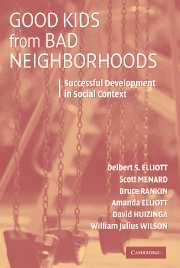Book contents
- Frontmatter
- Contents
- List of Tables and Figures
- Foreword by Richard Jessor
- Acknowledgments
- 1 Growing Up in Disadvantaged Neighborhoods
- 2 Growing Up in Denver and Chicago: The MacArthur Neighborhood Study
- 3 Good and Bad Neighborhoods for Raising Children
- 4 The Effects of Growing Up in a Bad Neighborhood: Initial Findings
- 5 Critical Dimensions of Neighborhood Organization and Culture
- 6 The Effects of Neighborhood Organization and Culture
- 7 Family Influences: Managing Disadvantage and Promoting Success
- 8 School Climate and Types of Peer Groups
- 9 What Matters Most for Successful Youth Development?
- 10 Successful Development in Disadvantaged Neighborhoods
- Appendix A
- Appendix B
- References
- Author Index
- Subject Index
10 - Successful Development in Disadvantaged Neighborhoods
Published online by Cambridge University Press: 06 August 2009
- Frontmatter
- Contents
- List of Tables and Figures
- Foreword by Richard Jessor
- Acknowledgments
- 1 Growing Up in Disadvantaged Neighborhoods
- 2 Growing Up in Denver and Chicago: The MacArthur Neighborhood Study
- 3 Good and Bad Neighborhoods for Raising Children
- 4 The Effects of Growing Up in a Bad Neighborhood: Initial Findings
- 5 Critical Dimensions of Neighborhood Organization and Culture
- 6 The Effects of Neighborhood Organization and Culture
- 7 Family Influences: Managing Disadvantage and Promoting Success
- 8 School Climate and Types of Peer Groups
- 9 What Matters Most for Successful Youth Development?
- 10 Successful Development in Disadvantaged Neighborhoods
- Appendix A
- Appendix B
- References
- Author Index
- Subject Index
Summary
We have invested millions of dollars to hire researchers to conduct failure studies of the poor. These researchers take their notebooks into low-income communities and tally how many people are on drugs and in prison, how many young girls are pregnant and how many youths have dropped out of school. They do not look for models of success – families that, in spite of similar circumstances, have raised children who have refused the lures of drugs and gangs, who have stayed in school, have not had babies out of wedlock…. Scholars on both the left and right make comfortable livings detailing the pathologies of the poor without ever talking with a single poor person.
(Woodson, The Triumphs of Joseph, 1998:10)INTRODUCTION
In this chapter we will look backward and forward: back to the questions we raised when we initiated this study on successful development in poor, disadvantaged neighborhoods, and forward to the program and policy implications of our findings. We do not provide a detailed summary of findings here (see the Synopsis and Discussion Sections of the individual chapters), but rather a broad overview of findings and a discussion of the general issues they raise for present and future policy and programs designed to improve youth development outcomes for those living in disadvantaged neighborhoods. Some of the more unusual or unexpected findings are also considered in more detail here.
- Type
- Chapter
- Information
- Good Kids from Bad NeighborhoodsSuccessful Development in Social Context, pp. 274 - 304Publisher: Cambridge University PressPrint publication year: 2006



